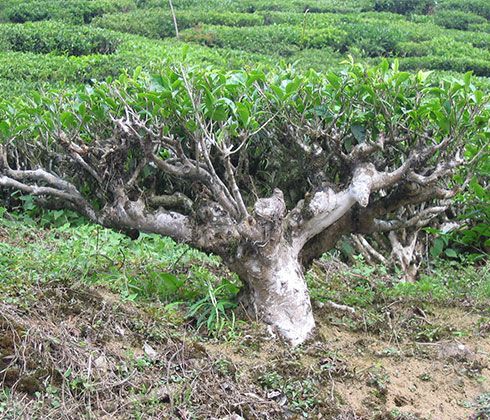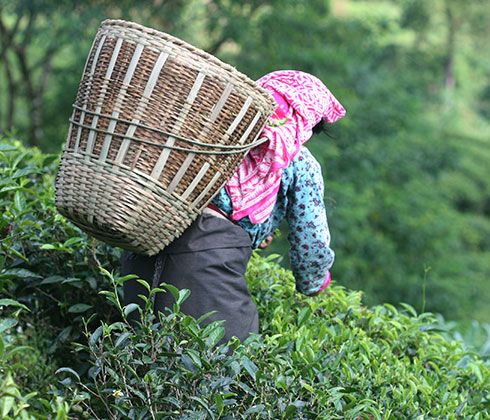The tea plantation
Tea plantations look like a huge forest made up of small trees that rarely reach above 1.5m in height.
When their trunks are thick and gnarled, they show that their age is much greater than their small size would suggest.
In their natural state tea plants can reach a height of 15 to 20m. If they are to be cultivated they are kept at a height of about 1.20m by regular pruning, in order to form what is known as the "plucking table", which facilitates hand plucking and encourages bud growth.

The tea tree
Pruned and shaped by man over 50 or so years, the tea plants become real dwarf-trees and form strange plantations, a mixture of massive green covers and miniature forests.
The tea plant belongs to the Camelia family. There are two main varieties of the camelia sinensis or thea sinensis: the Chinese type, known as sinensis, with small and olive green leaves; and the Assam variety, known as assamica, which has large, pale, plump leaves. Other varieties have now appeared as a result of hybridization, grafting, propagation from cuttings etc, with many hybrids known as jats or clonals.
The cultivated tea plant is a bush with evergreen leaves, the upper surfaces of which are shiny and the undersides matt and paler. The young leaves and buds are covered with a light, silvery down, hence their name known as "Pekoe" after the Chinese word Pak-ho which means "fine hair" or "down".
The main growing countries are :
- In Asia : China, India, Japan, Taiwan, Nepal, Sri Lanka, Indonesia, Malaysia, Vietnam, Bangladesh.
- In Africa : Cameroon, Mauritius, Kenya, Rwanda, Zimbabwe.
- In South America : Argentina, Brazil.
- Around the Caspian and Black Seas : Georgia, Iran and Turkey.
Ecology
The top average temperature is between 18°C and 20°C and should have little daily variations. The climate has an affect both in the volume and the quality of the harvest.
A climate too humid will give a lower quality, while a dry season can often bring higher quality harvests. High altitude also improves quality with a smaller yield. In tropical regions, the tea plant can be cultivated at altitudes ranging from sea level up to 2,500m.
Sunlight is important: it is necessary for the formation of the essential oils that give the brew its aroma. The light should preferably be scattered: this is why large trees are regularly planted on tea plantations, they regulate the soil ecology and filter the strong sunrays.
The soil should be permeable, loose and deep since the tea plant's roots can push down to a depth of up to 6m. Soil cover should be at least 1.5m deep. The best areas have a young, volcanic soil which is very permeable and rich in humus, neither basal nor too clayey. Tea is always grown on sloping ground, allowing for natural drainage, since the tea plants, unlike rice plants, cannot survive in stagnant water. This drawback is also a trump card: the tea plant is very resilient, it can be grown on extreme gradients and is perfectly suited to the most steeply-sloping, mountainous terrain.

Cultivation
Growing tea used to be done from seeds that were re-planted. Nowadays reproduction of tea plants is basically accomplished by taking cuttings from selected plants.
The cuttings are taken from the chosen plants and then replanted onto nursery beds where they will remain for 12 to 18 months. As soon as they turn into young plants, they are replanted in the main plantation, being spaced out in such a way that the fully grown bushes will cover the entire area when they reach maturity.
The plant is left for 4 years before any leaves can be plucked. Constant pruning and shaping will form its required height of 1.20m, hence creating the plucking table and giving a good framework to the bush. It will not reach full growth until the fifth year when it will begin to produce. It will still be pruned at varying intervals - on average every two years - in order to keep it at a good height for plucking.
A mature tea plant does not usually live for more than 40 or 50 years. Nonetheless some varieties can live up to 100 years. At the end of the fifth year, the tea plant is ready to be harvested. This operation, which consists of a light, repeated, pruning of the young shoots, is carried out in a 7 to 15 days cycle, depending on the growth, the climate and the amount of tea to be plucked.
Tea plucking
A small bud forms at the end of each stem and quickly becomes a young shoot. This end leaf is usually curled and forms the bud. Other leaves are found on the stem and their number below the bud will determine the quality of the plucking: the more are removed, the lesser quality plucking.
There are three types of plucking:
- the imperial plucking: the bud and the leaf that directly follows.
- the fine plucking: the bud and the two leaves that follow. This is a harvest of excellent quality.
- the average plucking: the bud and the three leaves that follow. This gives a lesser quality tea than the previous two but it allows the tea plant to grow better.
The leaves are never plucked separately: the part of the stem that unites the young shoot and the leaves is always plucked as a whole. In order to obtain some much sought-after teas, the 4th and 5th leaves, also called Souchong, are picked. These are usually to be found in smoked Chinese teas. After a certain period of time the tea plant will have stems with no young shoots. This marks the resting period. The end bud is formed of the "deaf" leaf which is then removed in order to allow the stems to recover.
Plucking is still done, in the majority of cases, by hand. Mechanization of tea plucking is still very rare; with some exceptions however:
- in Japan scissors are used.
- also in Japan, and in Georgia, mechanized clippers are used to straddle the rows and pluck an area with a width of 1.5m. This method presupposes a flat terrain and a large harvest, except in Japan where mechanization is very advanced but also very expensive.
- in Argentina, tractors are used.
Plucking seasons in Asia:
- China: February to November,
- Northern India: February to November,
- Southern India: all year round,
- Indonesia: all year round,
- Japan: 4 times a year, from May to October,
- Sri Lanka: all year round except in high altitude,
- Taiwan: mainly in Spring, summer and autumn.
